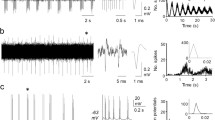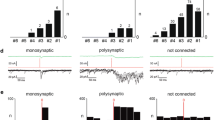Abstract
Microelectrode recordings were made of discharges of ventral horn interneurons (VHIN) in segments L6–7 of the spinal cord during bilateral stimulation of the motor cortex in cats. The overwhelming majority of VHIN was shown to be activated by influences from the contralateral cortex, and about half of them also by ipsilateral influences. Clear correlation was established between convergence of afferent and cortical influences: Neurons with inputs from ipsilateral afferents only were activated, irrespective of their other characteristics, by descending influences from the contralateral cortex only, whereas bilateral cortical influences converged on cells with bilateral afferent connections. It is suggested that VHIN with bilateral segmental and supraspinal connections are important integrative elements in the mechanism of bilateral coordination of motor responses of different degrees of complexity.
Similar content being viewed by others
Literature cited
T. Anastasievic, D. A. Vasilenko, A. I. Kostyukov, and N. N. Preobrazhenskii, “Reticulofugal influences of interneurons in the lateral region of gray matter of the cat spinal chord.“ Neirofiziologiya,5, 525 (1973).
I. S. Bezhenaru, A. P. Gokin, A. G. Zadorozhnyi, and N. N. Preobrazhenskii, “Synaptic activation of thoracic spinal interneurons by reticulospinal pathways,” Neirofiziologiya,4, 566 (1972).
E. T. Blagodatova, S. A. Evdokimov, L. S. Evstigneeva, and P. A. Kiselev, “Interaction between symmetrical cortical influences and lumbar motoneurons,” Fiziol. Zh. SSSR,62, No. 1, 47 (1976).
D. A. Vasilenko, A. G. Zadorozhnyi, and P. G. Kostyuk, “Synaptic processes in spinal neurons activated monosynaptically by the pyramidal tract,” Byull. Eksp. Biol. Med.,64, No. 11, 20 (1967).
A. P. Gokin, A. I. Pilyavskii, and I. Pavlassek, “Synaptic activation of thoracic interneurons by reticulospinal fibers of the lateral funiculus,” Neirofiziologiya,10, No. 2, 150 (1978).
A. G. Zadorozhynyi, D. A. Vasilenko, and P. G. Kostyuk, “Pyramidal influences on interneurons of spinal segmental reflex arcs in the cat,” Neirofiziologiya,2, No. 1, 17 (1970).
V. I. Saf'yants, Bilateral Integrative Activity of the Spinal Chord [in Russian], Nauka, Leningrad (1976), p. 186.
J. M. Besson and J. P. Privot, “Heterosegmental, heterosensory, and cortical inhibitory effects on dorsal interneurons in the cat's spinal cord,” Electroenceph. Clin. Neurophysiol.,33, No. 2, 195 (1972).
R. E. Burke, A. Lundberg, and F. Weight, “Spinal border cells origin of the ventral spinocerebellar tract,” Exp. Brain Res.,12, 283 (1971).
E. E. Fetz, “Pyramidal tract effects on interneurons in the cat lumbar dorsal horn,” J. Neurophysiol.,31, 69 (1968).
T. C. Fu, E. Jankovska, and R. Tanaka, “Effects of volleys in corticospinal tract fibres on ventral spino-cerebellar tract cells in the cat,” Acta Physiol. Scand.,100, 1 (1977).
H. Hultborn and M. Santini, “Supraspinal control of monosynaptically activated group Ia interneurons in the ventral horn,” Acta Physiol. Scand.,84, No. 1, 142 (1972).
K. Koizumi, J. Ushijama, and C. Brooks, “A study of recticular formation action on spinal interneurons and motoneurones,” Jpn. J. physiol.,9, No. 3, 282 (1959).
P. G. Kostyuk, D. A. Vasilenko, and E. Lang, “Propriospinal pathways in the dorsolateral funiculus and their effects in lumbosacral motoneuronal pools,” Brain Res.,28, 233 (1971).
A. Lundberg, U. Norsell, and P. Voorhoeve, “Pyramidal effects on lumbosacral interneurones activated by somatic afferents,” Acta Physiol. Scand.,56, 200 (1962).
A. Lundberg and F. Weight, “Functional organization of the ventral spinocerebellar tract,” Exp. Brain Res.,12, 295 (1971).
M. Matsushita, “Some aspects of the interneuronal connections in cat's spinal gray matter,” J. Comp. Neurol.,136. 57 (1969).
J. B. McLean and H. Leffman, “Supraspinal control of Renshaw cells,” Exp. Neurol.,18, 94 (1967).
R. D. Skinner, W. D. Willis, and M. B. Hanecock, “Action of ventral cord pathways on spinal neurons,” Exp. Neurol.,27, 318 (1970).
P. D. Wall, “The laminar organization of dorsal horn and effects of decending impulses,” J. Physiol. (London),188, No. 3, 403 (1967).
Author information
Authors and Affiliations
Additional information
Translated from Fiziologicheskii Zhurnal SSSR imeni I. M. Sechenova, Vol. 65, No. 8, pp. 1172–1180, August, 1979.
Rights and permissions
About this article
Cite this article
Blagodatova, E.T., Predtechenskaya, K.S., Evdokimov, S.A. et al. Bilateral influences from the motor cortex on lumbar ventral horn interneurons. Neurosci Behav Physiol 11, 488–494 (1981). https://doi.org/10.1007/BF01182803
Received:
Issue Date:
DOI: https://doi.org/10.1007/BF01182803




